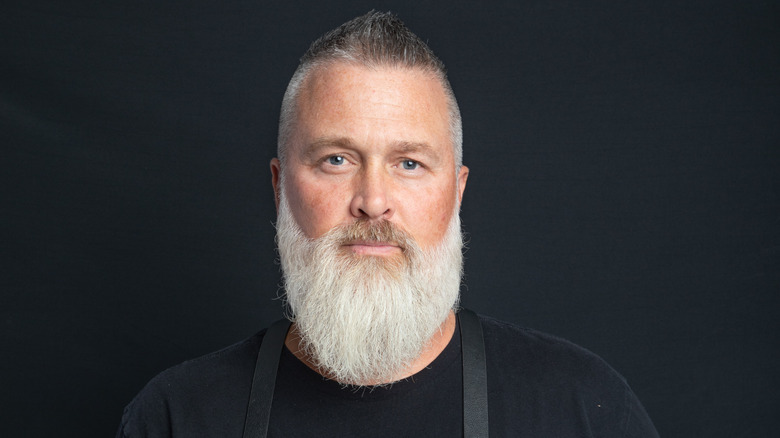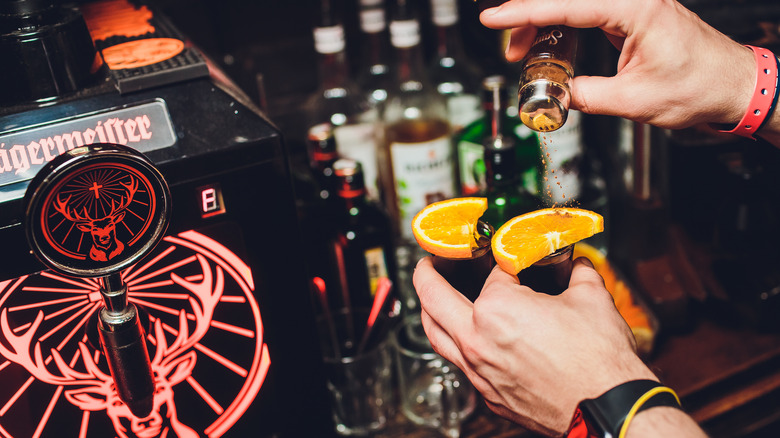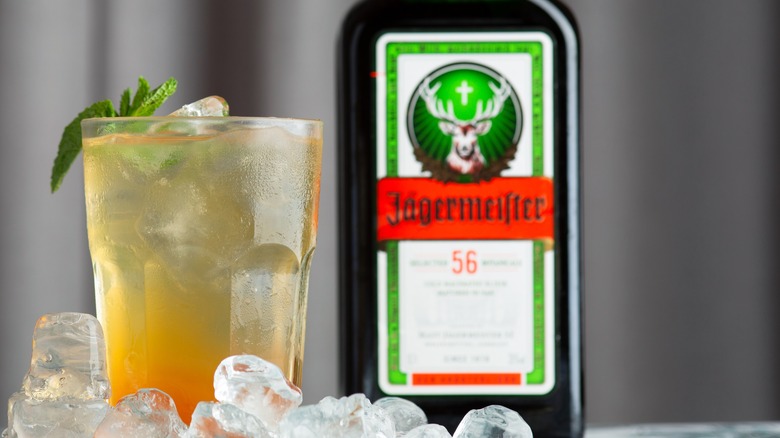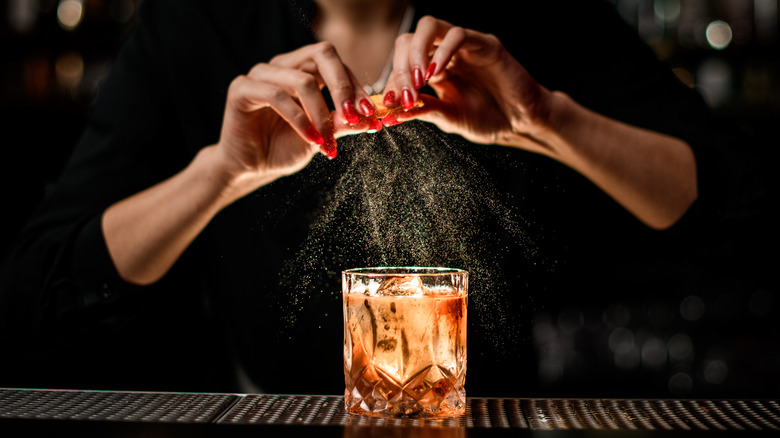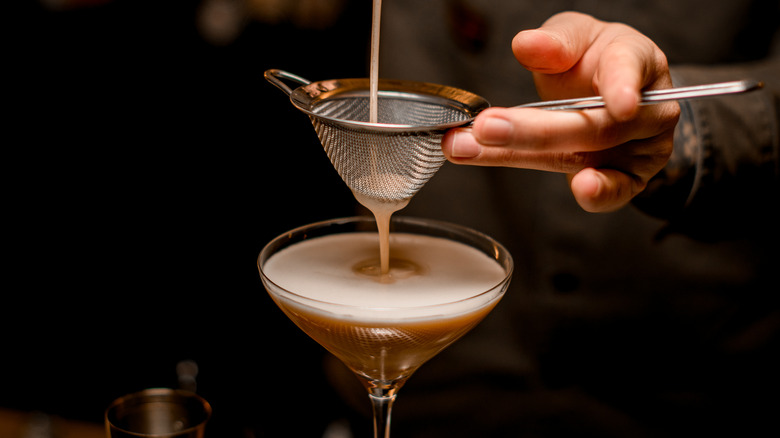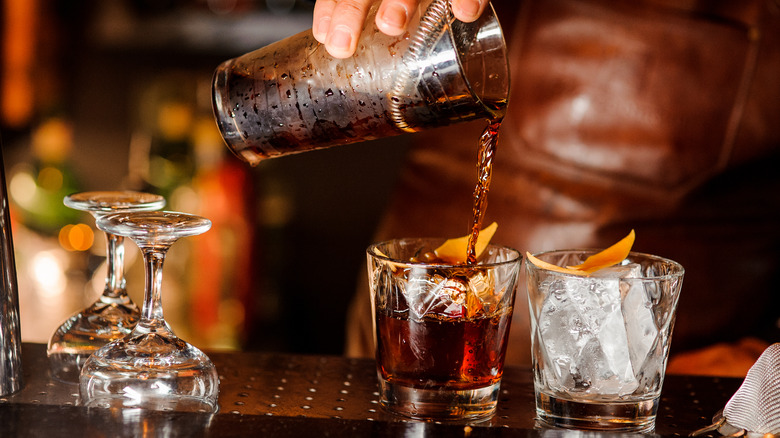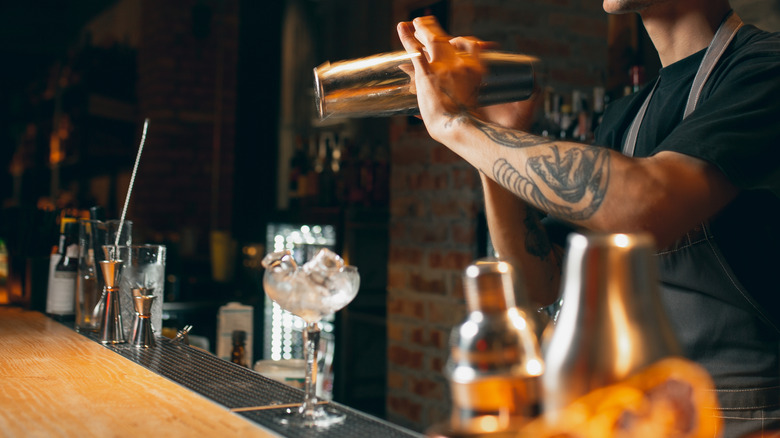Jägermeister Brandmeister Willy Shine Recommends The Best Infusions And Cocktails - Exclusive Interview
Willy Shine, current Jägermeister Brandmeister, first got to know the drink in the '90s. This was back when Jäger was served almost exclusively as an ice-cold shot and was, predominately, a musician's best friend. Back then, you might have found Shine working behind a bar in Aspen or Nantucket. Not only was Jägermeister his "bartender's handshake" of choice (more on that later), but cocktails were making their big comeback. Willy Shine would become a master of both.
Just like Auguste Escoffier promoted the culinary world's five mother sauces, Jägermeister's Brandmeister firmly believes in the basic "sauces" of the cocktail universe. "There's really only about seven to 11 — arguably — recipes for cocktails, but then the world is yours," Shine told Mashed. For the past six years or so, he's been using his cocktail prowess to introduce the world to another, more complex, side of Jägermeister's identity.
In this exclusive interview, Shine presents us with a liqueur that sings notes of clove, ginger, cardamom, and nutmeg, and that is — Shine assured us — as at home in an old fashioned as it is in a tiki cocktail. Follow along for unmissable cocktail tips, bar-ordering strategies, and bartending anecdotes as told by an industry legend.
Willy Shine remembers Jägermeister in the '90s
You say your first introduction to the brand was in the '90s when Jägermeister was considered a bartender's handshake. Explain that.
I started bartending [around] 1992. Everybody had Jägermeister in their ice bin. That's totally unsanitary, but that's what bartenders did. We kept it in the ice bin and all of our bartender friends and anybody that you knew, this is what you poured. It was Jägermeister. Even when I lived in Aspen, Colorado, and Nantucket Island and towards the late '90s and early 2000s, that was the bartender handshake of the time.
It wasn't just me. It was a national thing ... As I started working with Jägermeister later on in my career in 2015, I learned so much more about that timeframe and why it was such an emotional ... the brand really cared for up-and-coming musicians and live music. We were very synonymous with music during that time.
Through the '80s and '90s, we were building this emotional connection with our consumer base ... It was a really nice time for the brand and the foundation of the brand in this country, was the bartender handshake and then [being] synonymous with music.
On your [Instagram], we you've done a fair amount of cooking with Jägermeister. What are some of your favorite Jägermeister-infused recipes?
One thing that I love to do is brining. If you think about brining meat in advance, that's a great way. Already, some of those ingredients that are in Jagermeister are there. That's a good one [if you] about brining. Another one is in barbecue sauces when you're barbecuing. If you make your own barbecue sauce, or if you have a favorite, if you mix in a little bit of Jägermeister there, that's a good one. If you smoke your barbecue, add Jägermeister to the spray bottle. That's another really good tip.
One of my favorite ones as well is ribs that Chef Santos has done that uses cherry cola and Jägermeister in the ingredients when he's marinating the ribs, which is a really good thing, too, a delicious one. You can really run the gamut with that as well, but those are some good ones.
Willy Shine on Jägermeister's secret recipe
There are 56 different botanicals sourced from all around the world in Jägermeister. The exact recipe is a secret, but can you give us examples of which botanicals are sourced from where?
There are 56 herbs, spices, roots, and flowers that go into making Jägermeister, and they are sourced all over the world. We don't really talk about exactly where they're coming from, and I'll tell you the reason why. When it comes down to the world trade market, when it comes to botanicals, it's like teas and bitters. There's a whole bunch of other types of companies that use these types of botanicals. For us, particularly, we always get it where it's growing the best.
It could change depending on the year of growth or something happened to that field or that farm. We never really talk about exactly where it's coming from, unfortunately, because I would love to talk about the farmers, the origins, and all those things, because that's me and what I do and how much I love what I do in that sense of the thing.
In this country, unfortunately, legally, we can only talk to about 11 of [the ingredients]. I never got to the understanding of why that is, but we can only speak to 11. These 11 are pretty much the ones that are the top notes anyway, because a lot of the other ones are buried in the harmony of it and stuff. The big ones are like star anise and cinnamon and clove and ginger and galangal, which is very similar to ginger, just a little bit more floral, [a] kind of cousin to ginger.
You got the bitter one, which is called floreta, a very bitter bark. Then, you have bitter orange and sweet orange. I might have said cardamom already. [There's also] mace, which is the outside shell of the nutmeg. Those are some of them that are inside Jägermeister, which also help with its versatility because a lot of those flavors work in a lot of different things.
Jägermeister's true flavor profile revealed
You've said that many bartenders are surprised to discover Jägermeister's true flavor profile when they drink it warm. What are some misconceptions about Jägermeister that you break to this day?
Whenever we evaluate wine, spirits, you're always supposed to evaluate it at room temperature. When we're talking about Jägermeister in our marketing and that kind of stuff, it's all about the ice cold shot because it's delicious that way. But when we're talking to bartenders and we're evaluating it, we're talking about where it comes from and its production, and how to really understand what the flavors are in it. You've got to evaluate it at room temperature.
One of the [big misconceptions] is the sugar content ... within Jägermeister. We are a liqueur, and in order to be a liqueur, it has to be a hundred grams per liter. We're not too far off of that, where a lot of our competitors are a lot higher. When it comes to sugar content, we're actually fairly low. When you do taste at room temperature, you can see that.
It also opens up the taste experience to get all of the aromas from all of these herbs and spices, as well as being able to get it on your palate. If you drink it ice cold ... it tightens up and it pushes forward the cinnamon and the clove and the licorice and the star anise. It becomes slightly viscous because it's ice cold and coming out of the tap machine.
[Another] misconception [is] of it being "this spirit that might do something to you." Everybody's like, "Jägermeister was the one," but everybody drinks so much, and then they have the Jägermeister. What we're trying to get across is that Jägermeister can be experienced and can be loved in multiple situations. It's very versatile. You could have it in celebratory moments. You can have it in cocktails.
One of my favorite drinks ... is called the Jäger-mericano, and it's a riff off of the Americano and it's a spritz-style cocktail. We are a digestive by our makeup because of the richness and the herbs and spices and the darkness of it. [You can drink it] after dinner to help you settle your stomach. Once you start making cocktails with it, you can play in the world.
[Jägermeister has a] very low ABV. If you were to take a half ounce of Jägermeister with a half ounce of your favorite sweet vermouth and pour that over ice in a very tall glass with mineral water and then do a little lemon peel and give it a stir, it is fantastic. It's one of my favorite ways to enjoy Jägermeister in a more modern way.
Inside Willy Shine's cocktail creation process
You do quite a bit of cocktail development with Jägermeister as part of your job. What's your favorite part of the process?
Cocktail creation is ... one of my favorite things to do. I come from the beginning of the world of bringing cocktails back. I had a lot of really wonderful mentors that brought me along ... Back in the '90s and early 2000s, not only did cocktails come back because of people discovering books, but it also came back because bartenders [were] learning from the kitchen a little bit. The combination of those two things was like the worlds coming together — the front of the house and the back of the house coming together.
One of our good friends, Chef Chris Santos ... he calls it "the heart of the house," being the kitchen and the bar coming together to create together. I dive deep. There's got to be some type of inspiration coming from somewhere, whether that's a song or whether that's a season, whether it's an ingredient ... art, a dish that I had at a restaurant with flavor pairings coming together that makes a light bulb go off. You're like, "Oh my God, this is amazing. I could make a drink and do it like this."
After all that, you got to have an understanding of what I was calling the mother sauces before. There's really only about seven to 11 recipes for cocktails, but then the world is yours ... if you know those, ehether it's a two-ounce, a base with a three-quarter citrus, three-quarter syrup — which would make a sour — which could be a daiquiri or a whiskey sour, or something along those lines.
Think about it. Instead of using rum, use whiskey or use gin or use any type of base spirit, and then your citruses are using lemon or lime, or you could mess with that and add some grapefruit, add a little pineapple, and your syrups are [never]-ending. You got sugar syrups, whether it's demerara or white sugar, you can use maple syrup, honey, agave, and then you can infuse all those things with different types of teas and botanicals, as well as the spirit. You can infuse the spirits as well.
Then it comes into, okay, here's Jägermeister. Here are the experiences. Here are the events I'm doing. Here's the national campaign ... You think about glassware, you think about not everything's going to be in a coop, not everything's going to be in a rocks glass, not everything's going to be a high ball. It's all about balance. Not everything's going to be sour. Some are going to be strong. Some are going to be tiki-esque, tropical. Some will play off of some of the baking spices, seasonal, all of these different things. This is where my head goes as far as building and creating cocktails from the beginning. It's a bit of an art form.
How to make a Jäger Rock
What's your favorite cocktail that you've developed for the brand?
I'll talk about three of them. One of them is a version of Thai tea. Thai tea is absolutely delicious, and you have to use that certain Thai tea that makes that color, but with Jägermeister, the flavor profile is amazing, with a little bit of lemongrass syrup that I made. [I'm] using lemongrass stock, breaking that down, steeping it in some water or 50/50 with a little sugar, and then a little bit of coconut milk. Then, I use Kaffir lime leaves on top for the aromatics. [It's an] unbelievable cocktail. Jägermeister and those flavors absolutely love each other. I had that in a competition a couple years back, and it did very well.
Another one that's really great and a simple one is a version of an old fashioned. The old fashioned is my favorite cocktail to riff off of. Everybody loves old fashions. The sipping, it's easy. It's nice. It's beautiful. It's decadent. It comes on a big cube and a nice glass, but it's simplified, if you think about it. You take either bourbon or rye whiskey with Jägermeister 50/50, and you stir that on a big cube with an orange peel or a lemon peel. You really made an old fashion with two touches, because Jägermeister already has the sugar and the bitters in.
This is a really nice one that some bars and some people that maybe aren't to the point yet of being able to pull in a little bit more technique [can do], to make it more decadent ... This is a really easy, awesome, delicious, simple old fashion variation. We call it the Jäger Rock, which is really simple.
How to elevate your espresso martini with Jäger
The other one is bringing back this espresso martini world. I've been around long enough to where I was making drinks in the '90s, and we were making espresso martinis when it first came out. Thank you to Dick Bradsel over in the UK who created it and [helped it to make] its way over the pond! We started making it and making riffs on it in this day and age, with our amazing, cool brew Jägermeister cool brew coffee.
I got to help make [it], which I'm so proud of ... It's absolutely delicious and has Jägermeister [undertones]. It's very coffee and a little bit of chocolate and ... cacao. We make our own cold brew. The coffee is from Colombia and Brazil ... It's absolutely delicious and it makes an incredible espresso martini.
[If] you want to do a basic espresso martini, you're going to use either vodka or vanilla vodka. It's about a half ounce of that with an ounce of Jägermeister cold brew coffee with a half ounce of simple syrup and then one ounce of either fresh brewed espresso or cold brew concentrate. The reason why we brought in cold brew concentrate is some bars don't have the ability to make espressos right away.
The reason why those two work the best, cold brew concentrate and espresso, is because when you stick with either of those, that's when you get the crema on top of your drink. That's what you're looking for in a good espresso martini. You can gauge the bar and the bartender by their espresso martini if they did it right by getting that crema on top. Your three coffee beans can sit nice and pretty up there...
If you wanted to take the espresso martini to the next level, [you can] bring it into fall time. One that I love to do is using a Reposado tequila instead of using vodka or vanilla vodka, because the age on the tequila will bring in some of those vanilla notes. Instead of using a half ounce of simple syrup, use a spiced honey syrup or a spiced agave syrup, by using cinnamon or clove or nutmeg and making a little syrup out of it. Then, us[e] your espresso or cold brew coffee and Jägermeister cold brew coffee ... It elevates it to a more craft [cocktail], but also brings it into some fall flavors, which is pretty cool.
When to order a cocktail at a bar, and when to steer clear
You just mentioned crema as a telltale sign of whether the bartender knows what he or she is doing. Having worked in the industry for so long, can you give us two or three top signs that when you walk in the bar, your bartender is on top of their stuff?
First of all, I'm not a judging guy. Depending on what bar I'm walking into, you take a quick look around and you know what you should be ordering. Number one is cleanliness of the bar, and I don't mean by it looking clean. That's very important — your bar should always be clean — but look at the back bar you're [seeing] behind me right now, everything's perfectly faced. It's got symmetry. The bar is really well put together and bottles are mirrored on either side.
You can tell by meticulousness if a bar is taking care of the level of expertise they may have in making cocktails. I would probably look at their cocktail menu at that point and then maybe choose something off of there by just looking at the bar and how well it's managed.
If I walk into a bar, and there's a free-base sink behind there, and they're washing the glasses in the free base sink, I tend to go for a bottled beer or something. That's just me, though. I've worked behind too many bars back in the day that had a free-base sink and it was not the best experience. I'll always order something that comes in a bottle if there's a free-base sink. No disrespect to anybody who does it well. It's hard to find, to be honest.
By looking at the bartenders and particularly looking at their movements and their techniques and how they're moving back there, you can tell when a staff is like a family and they work together well, because it becomes a little dance back there. It's really fun to watch when they know who they're working with and they work well together. There's this bit of a dance that goes behind a bar when you've been working together for a while and you can tell that they've been doing it for a while.
Willy Shine shares how to impress your barkeep
If you want to impress a bartender when you walk into a bar, what should you order?
That depends on the bar you walk into. You don't want to walk into a dive bar and ask for a gin fizz; they'd probably pass you on to the next one. Walking to a nice neighborhood bar, a dive bar scenario, something like that, and you get talking to the bartender a little bit and you ask them about what type of a tequila, what type of a liqueur and amaro section they have. Get a conversation going if you have the time. That's a nice way to win them over.
Ordering the Jägermeister Rye is a great one because that's probably something that they hadn't thought of before. You would impress them by that because they'd be like, "Huh, oh, Jägermeister with a little rye whiskey. That sounds good. Let's give it a shot." That would be a good way to do it. As far as a very busy bar goes, a little tidbit: Wait for the moment to keep the eyes with the bartender and try to sneak your way in there and over tip on the first round. That's always a good one.
Visit the Jägermeister website to find out which of their products you can responsibly enjoy near you.

